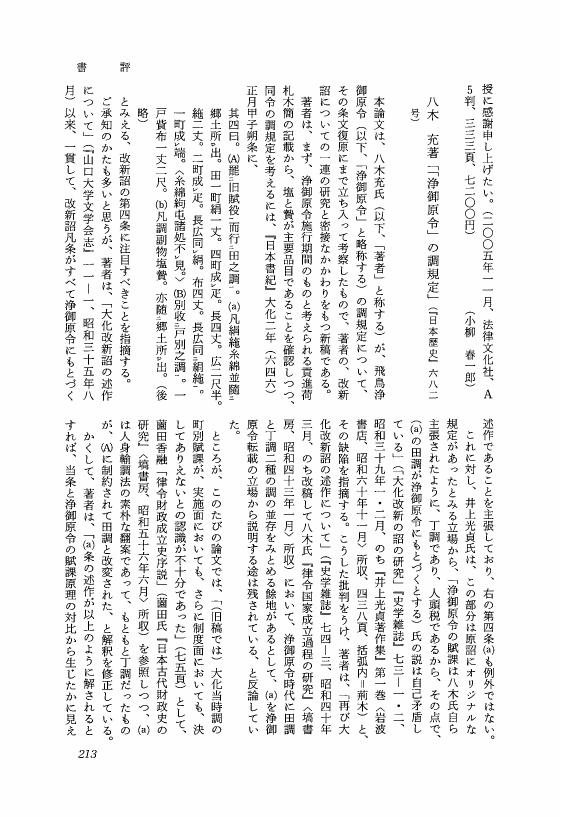1 0 0 0 米国からの教育使節:デビット・マレー
- 著者
- 明石 紀雄
- 出版者
- 筑波大学
- 雑誌
- 筑波大学地域研究 (ISSN:09121412)
- 巻号頁・発行日
- vol.1, pp.111-121, 1983-03
- 著者
- 内川 隆志
- 出版者
- 國學院大學博物館学研究室
- 雑誌
- 國學院大學博物館學紀要 (ISSN:02865831)
- 巻号頁・発行日
- vol.28, pp.3-28, 2003
- 著者
- 古賀 徹
- 出版者
- 日本大学文理学部人文科学研究所
- 雑誌
- 研究紀要 (ISSN:02866447)
- 巻号頁・発行日
- no.54, pp.107-123, 1997
1 0 0 0 学監ダビッド・マレーの研究
- 著者
- 稲垣 友美
- 出版者
- 早稲田大学哲学会
- 雑誌
- フィロソフィア (ISSN:05540690)
- 巻号頁・発行日
- no.29, pp.100-123, 1955-12
1 0 0 0 モルレー氏「身体の教育」見込書について
- 著者
- 能勢 修一
- 出版者
- 鳥取大学学芸学部
- 雑誌
- 鳥取大学学芸学部研究報告 教育科学 (ISSN:05639638)
- 巻号頁・発行日
- no.3, 1962-01
- 著者
- 佐藤 秀夫
- 出版者
- 日本大学文理学部人文科学研究所
- 雑誌
- 研究紀要 (ISSN:02866447)
- 巻号頁・発行日
- no.57, pp.169-187, 1999
1 0 0 0 :David Murrayと「学監考案日本教育法」
- 著者
- 仲 新
- 出版者
- Japanese Educational Research Association
- 雑誌
- 教育学研究 (ISSN:03873161)
- 巻号頁・発行日
- vol.23, no.2, pp.39-51, 1956
1 0 0 0 来日前のダビット・モルレーについて
- 著者
- 羽田 積男
- 出版者
- Japan Comparative Education Society
- 雑誌
- 日本比較教育学会紀要 (ISSN:02871106)
- 巻号頁・発行日
- vol.1986, no.12, pp.75-81, 1986
- 著者
- 古賀 徹
- 出版者
- 東京大学史史料室
- 雑誌
- 東京大学史紀要 (ISSN:03867684)
- 巻号頁・発行日
- no.19, pp.17-33, 2001-03
- 著者
- 財部 香枝
- 出版者
- 全日本博物館学会
- 雑誌
- 博物館学雑誌 (ISSN:03894444)
- 巻号頁・発行日
- vol.30, no.1, pp.21-46, 2005-01
1 0 0 0 マレー夫妻の手紙
- 著者
- 青山 なを
- 出版者
- 東京女子大学比較文化研究所
- 雑誌
- 比較文化 (ISSN:04408047)
- 巻号頁・発行日
- no.11, pp.105-169,図2p, 1965-02
1 0 0 0 OA 123 クリスタルアッシュの層位と対比
- 著者
- 矢口 裕之 小森 郁美 長谷川 桂子
- 出版者
- 日本地質学会
- 雑誌
- 日本地質学会学術大会講演要旨
- 巻号頁・発行日
- vol.99, 1992-03-25
1 0 0 0 OA (書評)八木充著「「「浄御原令」の調規定」(『日本歴史』六八二号)」
- 著者
- 荊木 美行
- 出版者
- 法制史学会
- 雑誌
- 法制史研究 (ISSN:04412508)
- 巻号頁・発行日
- vol.2006, no.56, pp.213-215, 2006 (Released:2012-07-17)
1 0 0 0 OA 視線が持つ社会的機能の個体発生・系統発生的起源に関する実験的研究
本研究の主要な成果はふたつある。(1)30種の霊長類について、目の形態・大脳新皮質率・群れサイズの要因の相関関係を解析し、ヒトを含む霊長類の目の外部形態の進化に社会的な要因が関与していた可能性をあきらかにした。(2)そのような形態的特徴を持つヒトは、発達初期から、「他者に注目される」ことを強化子として新たな行動を学習可能であることを、生後6か月の乳児を対象とした行動実験から実証的に示した。視線を介した我々のコミュニケーションは、生物学的基盤に立ちつつ、ヒトがヒトたる所以のひとつである学習にも大きな影響を及ぼしていることが明らかになった。
1 0 0 0 食品成分間相互作用と味覚修飾 (特集 食品の複雑系を解き明かせ)
- 著者
- 朝倉 富子 石丸 喜朗
- 出版者
- シーエムシー出版
- 雑誌
- Bio industry (ISSN:09106545)
- 巻号頁・発行日
- vol.31, no.8, pp.3-8, 2014-08
1 0 0 0 IR 不審な挙動の検知による内部犯対策(その2)
- 著者
- 丸岡 弘和 杉浦 敏文 西垣 正勝
- 出版者
- 情報処理学会
- 雑誌
- 情報処理学会研究報告コンピュータセキュリティ(CSEC) (ISSN:09196072)
- 巻号頁・発行日
- vol.2006, no.26, pp.203-208, 2006-03-17
近年,内部不正者による情報漏洩が社会問題となっている.我々は,ユーザが不正を行う際に不審な挙動が現れることに着目し,内部不正者のリアルタイム検知を実現する方式を検討している.これまでに「横目で周囲を確認する(チラ見)」という行動の検出による内部犯検知の可能性を探ったところ,被験者は実験を重ねる内に徐々に自分の体の制御の仕方を覚え,チラ見を発生させずに不正を行うことができるようになることが判明した.そこで本稿では,不正を行う際のユーザの心理状態の変化をダイレクトに検出できる心拍数の変化を内部犯検知に利用する手法を導入する.心拍数を自分で制御することは基本的には難しいため,訓練を重ねた内部不正者であっても不正の検知を回避することはより困難になると考えられる.本手法について,新たに基礎実験を行うことによりその有効性を確かめる.We proposed a real-time detection of internal fraud by sensing insider's suspicious behavior in our previous work, but in which we found that experimented insiders could be able to control their behavior and avoid detection of their fraud. Therefore, in this paper, we introduce to detect heartbeat interval of insiders. It is well known that when human being gets nervous, his/her heartbeat interval will immediately change. Since it is impossible for human being to control heartbeat, it is expected that using heartbeat interval as a suspicious behavior makes it more difficult for even experienced insiders to avoid detection. By conducting some experiments, we evaluate its effectiveness.
1 0 0 0 OA 官報
- 著者
- 大蔵省印刷局 [編]
- 出版者
- 日本マイクロ写真
- 巻号頁・発行日
- vol.1885年11月07日, 1885-11-07
1 0 0 0 OA 官報
- 著者
- 大蔵省印刷局 [編]
- 出版者
- 日本マイクロ写真
- 巻号頁・発行日
- vol.1885年11月11日, 1885-11-11
1 0 0 0 明治初期教育事務の成立 : 田中不二麿と明治十二年教育令
- 著者
- 湯川 文彦
- 出版者
- 公益財団法人史学会
- 雑誌
- 史學雜誌 (ISSN:00182478)
- 巻号頁・発行日
- vol.121, no.6, pp.1045-1083, 2012-06-20
This article attempts to clarify the ideas about an educational system held by Tanaka Fujimaro, vice-minister of education, who introduced school reforms during the early Meiji Period, in order to show that the foundations of educational administration in modern Japan were built upon the Education Act of 1879, which was formulated through Tanaka's involvement from draft proposal to the passage of the bill. The research to date has been unable to deal with the question of Tanaka's ideas about educational institutions and intentions concerning educational legislation, due to the complete absence of source materials on these subjects. However, the author of this article, utilizing a collection of articles on education found in the National Diet Library's Hosokawa Junjiro Collection, has been able to trace Tanaka's ideas and legislative activities in the following manner. Although the early Meiji Period government did set up a Ministry of Education entrusted with the administrative task of educating and training the nation, the Ministry lacked any fixed ideals or methodology about how to realized such a goal. It was Tanaka Fujimaro who first set about responding to the Ministry's mandate, beginning with the application of his observations of institutions in Europe and the United States as a member of the Iwakura Mission to what he considered appropriate to the task of administering educational affairs in Japan, summarized in his "Draft Proposal of an Education Bill". The Draft Proposal, which covered the realms of school, society and the household, aimed to transform general education into the major task of government, based on academic and educational freedom. Although Tanaka met with resistance concerning his idea of legislative bureaus for organizing human resource development and local autonomy, he was able to convince his opponents as to their significance. The Draft also addressed the questions of local autonomy and fiscal difficulties in the name of the establishment of educational administration. Furthermore, as deliberation on the Draft began in the Chamber of Elders, Tanaka took advantage of the legislative revision committee system to guide the Draft through the process of compromise and improvement, resulting in the preparation of a set of provisions indispensable to educational affairs, which upon their passage into law determined the future of administration from that time on.

